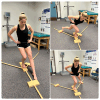Ankle Stability and Single-Leg Balance Control in Collegiate Female Soccer Players versus Non-Soccer Players
- PMID: 39807291
- PMCID: PMC11728582
- DOI: 10.70252/CQMP3296
Ankle Stability and Single-Leg Balance Control in Collegiate Female Soccer Players versus Non-Soccer Players
Abstract
Ankle sprains are common in female soccer players. Ankle injuries have the potential to impact balance control, which can further contribute to recurrent injuries. This study aimed to examine if female collegiate soccer players exhibited worse ankle stability and single-leg balance than female non-soccer players, and whether there was a correlation between ankle stability and single-leg balance. Eighteen female collegiate soccer players and 22 female non-soccer players participated in the study. The Cumberland Ankle Instability Tool (CAIT) was used to evaluate ankle stability. The Athletic Single Leg Stability Test (ASLST) of the Biodex Balance System was used to examine static single-leg balance, and the Y-Balance Test (YBT) was used to examine dynamic single-leg balance. Results show that 55.56% of soccer players and 9.09% of non-soccer players exhibited chronic ankle instability. The CAIT score of soccer players was significantly lower than non-soccer players (p = .031). There were no significant differences between the two groups in the ASLST and the YBT. Very low correlations were found between the CAIT score and any static or dynamic balance measures (r < .094). Female soccer players who exhibited worsened ankle stability did not exhibit compromised static or dynamic single-leg balance. Future studies should examine if soccer players have established better motor control of single-leg standing through years of training to compensate for worse ankle stability. In addition, the CAIT score alone might not accurately represent static or dynamic balance control in female collegiate soccer players.
Keywords: Proprioception; athletes; motor control; neuromuscular.
Figures





References
-
- Arifin N, Abu Osman NA, Wan Abas WA. Intrarater test-retest reliability of static and dynamic stability indexes measurement using the Biodex Stability System during unilateral stance. J Appl Biomech. 2014;30(2):300–4. - PubMed
-
- Cachupe WJ, Shifflett B, Kahanov L, Wughalter EH. Reliability of biodex balance system measures. Meas Phys Educ Exerc Sci. 2001;5(2):97–108.
LinkOut - more resources
Full Text Sources
